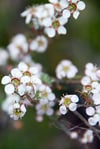Leptospermum myrsinoides - Silky Tea-Tree
Leptospermum myrsinoides - Silky Tea-Tree
Habit and Habitat:
Leptospermum myrsinoides, commonly known as Silky or Heath Tea Tree, is a charming Australian native plant celebrated for its distinct habit and habitat. It is a hardy evergreen shrub that typically grows in heathlands, woodlands, and coastal areas, thriving in well-drained soils.
Place in Local Habitat and Ecosystem Distribution:
Silky Tea-Tree plays a vital role in local ecosystems, providing habitat and sustenance for native fauna. Its presence in heathlands and coastal regions contributes to biodiversity, attracting pollinators and serving as a refuge for small birds and insects.
Planting Companions:
In your home garden, consider planting Silky Tea-Tree alongside other larger heath species like Grevillea, Banksia, and Allocasuarina. These companion plants create a visually appealing and ecologically harmonious landscape.
Human and Wildlife Uses:
Silky Tea Tree has medicinal properties. The leaves are brewed into a tea with purported healing qualities. In the garden, it attracts bees and other pollinators, contributing to the overall health of the ecosystem.
Care Instructions:
To cultivate Silky Tea-Tree successfully, choose a sunny location with well-drained soil. Once established, it is relatively low-maintenance, requiring occasional pruning to maintain shape and remove spent flowers. Drought-tolerant once mature, it is well-suited to Australian garden conditions.
Size, Height, Width, Flower, and Leaf Characteristics:
Silky Tea-Tree typically grows to a height of 1 to 2 meters with a similar spread. The foliage is characterized by small, narrow leaves with a silky texture, giving the plant its name. Delicate white or pink flowers bloom in clusters, creating a stunning contrast with the green foliage.
Latin Etymology:
The genus name "Leptospermum" is derived from Greek, where "leptos" means slender, and "sperma" means seed, describing the plant's slender seed capsules. The species name "myrsinoides" refers to its resemblance to plants in the Myrsinaceae family.
Planting Guidelines:
To plant Silky Tea-Tree in your home garden, ensure well-drained soil and provide adequate sunlight. Mulching around the base helps retain soil moisture. Regular pruning after flowering enhances bushiness and encourages a profusion of blooms.

